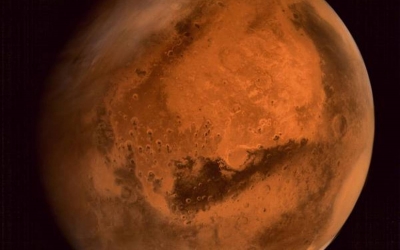
When it comes to exploratory missions to space, Mars comes second only to our own moon. So during the period that is dubbed the Space Race (competition in the second half of the 20th Century between Cold War adversaries – the U.S. and the Soviet Union), Mars missions gained prominence when the race to land humans on the moon had been won by the U.S.
The Soviet Union, in fact, launched four missions to Mars in a period of 20 days in July-August 1973. Named Mars 4, 5, 6 and 7, the first two were intended to orbit Mars and map its surface, while the last two were to land capsules on the Martian surface.
Orbit and relay
The sister of Mars 4, Mars 5 was launched on July 25, 1973. Tasked to orbit Mars, the mission’s objective included relaying information about the composition, structure and properties of the Martian surface and atmosphere, apart from serving as a communications link to Mars 6 and 7.
With two deployable fixed solar arrays and batteries to power the spacecraft, the launch mass of the orbiter was 3,440 kg. After being launched into Earth orbit, Mars 5 was then pushed onto a trajectory that would take it to the red planet.
Vega and Zufar
Equipped with a television imaging system that consisted of two cameras, Mars 5 had the capability to produce pictures with resolutions of 100 m to 1 km. The two cameras, called Vega and Zufar, could snap images through blue, red, and green filters, in addition to a special orange filter. These could then be facsimile scanned and sent to Earth. Apart from this two-camera system, Mars 5 also had another single-line scanning device to provide panoramic images in the visible and near-infrared.
Following course corrections on August 3 and February 2, 1974, the spacecraft reached Mars on February 12. It then successfully fired its engine to enter orbit around the planet.
Slow depressurisation
It was then that a problem was detected. Ground controllers noticed that the main instrument compartment on the orbiter was undergoing slow depressurisation following the successful orbital insertion. While they couldn’t say it for certain, the reason was suggested to be probably the result of an impact with a particle, either during or after orbital insertion.
As a result of this issue, it was deduced that Mars 5 effectively had very less time left for active science. To be more precise, calculations showed that approximately three weeks of operational duty was possible at the rate at which it was losing air.
Accelerated programme
An accelerated science programme was drawn by the scientists to make the most of the available time left. As a result, five imaging sessions, including those that imaged the surface at 100 m resolution, were achieved in a 10-day period from February 17-26. A total of 180 frames were produced, 43 of which proved to be useful images. In addition to these, Mars 5 also captured five panoramas of the Martian surface.
The last communication with Mars 5 took place on February 28, when the final panorama was transmitted back to Earth. After this, the pressure in the spacecraft decreased to such a level that it wasn’t possible for it to continue working any longer.
Apart from these images, which clearly showed surface features and even indicated possible erosion, data returned from Mars 5 also showed maximum surface temperatures of the planet. It even detected an ozone layer around Mars, albeit one that was about one-thousandth the concentration of the ozone layer around Earth.
An early end to the Mars 5 mission meant that it couldn’t achieve a lot more than it possibly could have. The abrupt end also obviously meant that it couldn’t serve as a data relay for the Mars 6 and Mars 7 lander missions that were launched days after it.
Picture Credit : Google




